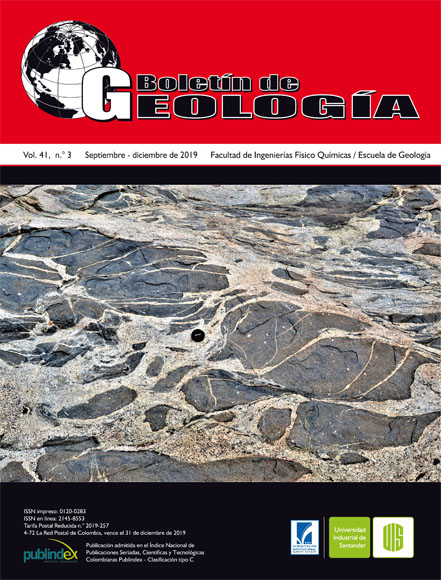2.5D Seismic tomography and geological features in the Urabá Basin (Colombia)
Published 2019-09-30
Keywords
- Urabá Basin,
- Faults,
- Seismic Tomography,
- 2.5D
How to Cite
Altmetrics
Abstract
There is little information and geological knowledge of the Urabá Basin. The results of the pseudo-3D (or 2.5D) tomographic study for the basin are presented. However, seismological data (passive seismic) allow an approximation of the disposition of some geological features in the subsurface, for example, guidelines and faults. Thus, by mean of the difference of travel times of the waves (P and S) that were recorded in the field and implementing a seismic inversion algorithm, a model was developed. This allowed estimating the seismic sources and the velocity distribution, also, to evaluate the disposition of the layers of rock in the subsurface until about 30 km of depth. With this, a contrast of velocity and a possible extension of the faults were identified, in the case of the Murindó fault to the north, and another fault with transverse orientation located in the Riosucio area.
Downloads
References
Bahrani, N., and Adler, A. (2012). 2.5D finite element method for electrical impedance tomography considering the complete electrode model. 25th IEEE Canadian Conference on Electrical and Computer Engineering, Montreal, Canada. doi: 10.1109/CCECE.2012.6334971.
Castillo, L.A., Kazmierczack, T., y Chemale, F. (2010). Estratigrafía de secuencia en un Modelo Dos y Medio Dimensional (2.5-d) del Cono de Rio Grande. Revista Geofísica, 62, 9-28.
Crosson, R.S. (1976). Crustal structure modeling of earthquake data. 1. Simultaneous least square estimation of hypocenter and velocity parameters. Journal of Geophysical Research, 81(17), 3036-3046.
Duque, H. (1980). Geotectónica y evolución de la región noroccidental colombiana. Boletín Geológico, 23(3), 4-37.
Feininger, T., and Bristow, C.R. (1980). Cretaceous and Paleogene geologic history of coastal Ecuador. Geologische Rundschau, 69(3), 849-874. doi: 10.1007/BF02104650.
Franco, L.E., Sánchez, J.J., Dionicio, V., and Castillo, L.F. (2006). Análisis de la sismicidad en cercanías al municipio de Dabeiba, departamento de Antioquia - Colombia. I Simposio Latinoamericano y del Caribe en Geofísica, II Congreso Latinoamericano de Sismología, III Congreso Colombiano de Sismología. Bogotá, Colombia.
González, J. (2012). Tomografía 3D de la Cuenca de Urabá a partir de datos de sísmica pasiva. Tesis de Maestría. Universidad Nacional de Colombia, Bogotá, Colombia.
Hernández, O. (2009). Proyecto: Cartografía geológica y modelamiento estructural de las cuencas de Urabá y Sinú - San Jacinto a partir de la interpretación de imágenes de sensores remotos y monitoreo sísmico. Universidad Nacional de Colombia - Agencia Nacional de Hidrocarburos, Colombia.
Iyer, H.M., and Hirahara, K. (1993). Seismic tomography: theory and practice. London: Chapman & Hai.
Lou, J., Eri, H., Can, A., Ramani, S., Fu, L., and De Man, B. (2016). 2.5D dictionary learning based computed tomography reconstruction. Proceedings SPIE, 9847, 98470L-1-98470L-12. doi: 10.1117/12.2223786.
Meissnar, R.O., Flueh, E.R., Stibane, F., and Berg, E. (1976). Dynamics of the active plate boundary in southwest Colombia according to recent geophysical measurements. Tectonophysics, 35(1-3), 115-136. doi: 10.1016/0040-1951(76)90032-9.
Nivia, A. (1989). El terreno Amaime-volcánica, una provincia acrecionada de basaltos de Meseta Oceánica. V Congreso Colombiano de Geología, Bucaramanga, Colombia.
Pavlis, T., and Mason, K. (2017). The new world of 3D geological mapping. GSA Today, 27(9), 4-10. doi: 10.1130/GSATG313A.1.
Ramadan, S. (2016). 3D geological modeling with multi-source data integration for ASL member in Rudies Formation Gulf of Suez. Qatar Foundation Annual Research Conference Proceedings, Doha, Qatar. doi: 10.5339/qfarc.2016.EESP3235.
RSNC. (2009a). Boletín de sismos enero - junio de 2009. Red Sismológica Nacional de Colombia, Bogotá, Colombia.
RSNC. (2009b). Boletín de sismos julio – diciembre de 2009. Red Sismológica Nacional de Colombia, Bogotá, Colombia.
Stein, S., and Wysession, M. (2003). An introduction to seismology, earthquakes, and earth structure. Oxford: Blackwell Science.
Suter, F., Sartori, M., Neuwerth, R., and Gorin, G. (2008). Structural imprints at the front of the Chocó-Panamá indenter: Field data from the north Cauca valley basin, Central Colombia. Tectonophysics, 460(1-4), 134-157. doi: 10.1016/j.tecto.2008.07.015.
Tarantola, A. (2005). Inverse problem theory and methods for model parameter estimation. Paris: Institute de Physique du Globe de Paris, Université de Paris 6.
Xiong, J.L., Lin, Y., Abubakar, A., and Habashy, T.M. (2013). 2.5-D forward and inverse modelling of full-waveform elastic seismic survey. Geophysical Journal International, 193(2), 938-948. doi: 10.1093/gji/ggt013.

